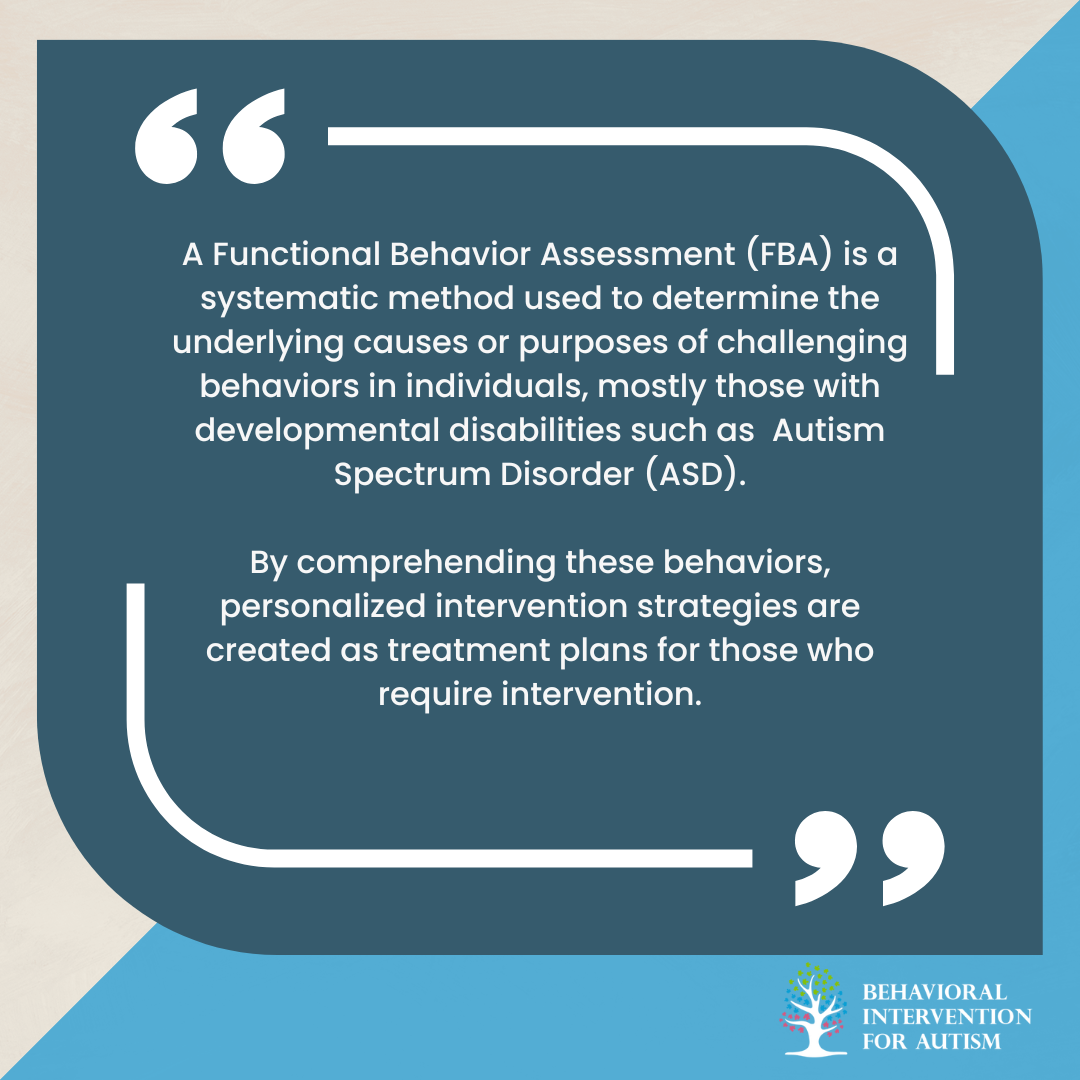
Table of Contents
Functional Behavior Assessment (FBA) is a systematic process used to identify the underlying causes or functions of challenging behaviors exhibited by individuals, particularly those with developmental disabilities or who have neurodivergent traits. Understanding these behaviors allows caregivers, educators, therapists, and parents to develop effective intervention strategies that are tailored to the individual’s specific needs.

The Purpose of FBA
The primary purpose of an FBA is to gather detailed information about the context in which a behavior occurs, the antecedents (events or conditions that precede the behavior), the behavior itself, and the consequences (events or conditions that follow the behavior). This information helps to identify the function or purpose that the behavior serves for the individual, which can typically be categorized into four main functions:
- Attention: The behavior is performed to gain attention from others.
- Escape/Avoidance: The behavior is used to avoid or escape from a situation or task.
- Access to Tangibles: The behavior is aimed at obtaining a specific item or activity.
- Sensory Stimulation: The behavior provides a form of sensory input that the individual finds pleasurable or regulating.
What is a Functional Behavior Assessment?
Steps in Conducting a Functional Behavior Assessment
Conducting an FBA involves several systematic steps to ensure that the information collected is accurate and comprehensive. Here are the typical steps involved:
Step 1: Defining the Behavior
The first step in an FBA process is to define the behavior that needs to be assessed. It should be observable, specific, and measurable. For example, instead of describing a behavior as “aggressive,” it should be defined in terms of specific actions such as “hitting,” “biting,” or “throwing objects.”
Step 2: Collecting Data
Data collection is a critical part of the FBA process. There are several methods used to gather information about the behavior, including:
- Direct Observation: Observing and recording the behavior as it occurs in real-time. This method provides firsthand information about the behavior and its context.
- Interviews: Conducting interviews with individuals who are familiar with the person exhibiting the behavior, such as parents, teachers, or caregivers. These interviews can provide valuable insights into the behavior and its possible triggers.
- Questionnaires: Using standardized questionnaires to gather information about the behavior from various perspectives. These questionnaires often include questions about the frequency, intensity, and duration of the behavior, as well as the situations in which it occurs.
Step 3: Analyzing the Data
Once the data has been collected, it needs to be analyzed to identify patterns and possible triggers for the behavior. This analysis typically involves:
- Identifying Antecedents and Consequences: Determining what happens before and after the behavior occurs. This helps to identify the events or conditions that might be triggering or maintaining the behavior.
- Looking for Patterns: Analyzing the data to identify consistent patterns in the behavior, such as specific times of day, settings, or activities that are associated with the behavior.
Step 4: Formulating Hypotheses
Based on the analysis of the data, the next step is to formulate hypotheses about the function of the behavior. These hypotheses are educated guesses about why the behavior is occurring and what purpose it serves for the individual.
Step 5: Testing the Hypotheses
To test the hypotheses, interventions are designed and implemented based on the identified function of the behavior. The effectiveness of these interventions is then monitored and evaluated to determine if the behavior changes in the expected way. If the behavior does not change as expected, the hypotheses may need to be revised and new interventions tried.
Importance of Functional Behavior Assessments
FBAs are essential tools in understanding and addressing challenging behaviors. Here are some key reasons why FBAs are important:
Developing Effective Interventions
By identifying the function of a behavior, FBAs allow for the development of targeted interventions that address the underlying cause of the behavior rather than just the behavior itself. This makes interventions more effective and sustainable in the long term.
Improving Quality of Life
FBAs help to reduce challenging behaviors and replace them with more appropriate and functional behaviors. This can significantly improve the individual’s quality of life by increasing their ability to participate in daily activities, form positive relationships, and achieve personal goals.
Enhancing Safety
Some challenging behaviors can pose a risk to the individual or others. FBAs help to identify these behaviors and develop interventions to reduce the risk and enhance safety.
Supporting Inclusion
By addressing challenging behaviors, FBAs support the inclusion of individuals with developmental disabilities in educational, social, and community settings. This promotes greater acceptance and opportunities for individuals with disabilities.
Real-World Applications of Functional Behavior Assessments
FBAs are used in a variety of settings and for a range of purposes. Here are some examples of how FBAs are applied in different contexts:
Educational Settings
In schools, FBAs are often conducted to address challenging behaviors that interfere with learning and classroom management. For example, a student who frequently disrupts the class by calling out might be found to be seeking attention. An intervention plan could then be developed to teach the student appropriate ways to gain attention and reinforce these new behaviors.
Home Settings
Parents and caregivers can use FBAs to understand and address challenging behaviors at home. For instance, a child who throws tantrums during mealtimes might be avoiding certain foods. An FBA can help to identify this pattern and develop strategies to gradually introduce new foods in a less stressful way.
Clinical Settings
In clinical settings, such as therapy or counseling, FBAs are used to develop individualized treatment plans for individuals with developmental disabilities or mental health conditions. For example, a therapist working with a child with ASD might use an FBA to identify triggers for self-injurious behavior and develop interventions to reduce these behaviors.
Challenges and Considerations in Conducting FBAs
While Functional Behavior Assessments (FBAs) are powerful tools, there are several challenges and considerations to keep in mind. Challenging behaviors can be complex and influenced by multiple factors, making it difficult to identify a single function for a behavior.
Additionally, behaviors may serve different functions in various contexts, further complicating the analysis. Conducting an FBA can also be resource-intensive, requiring significant time and resources, including trained professionals, extensive observations, and tools for data collection and analysis.
Moreover, effective FBAs require collaboration among various people, such as parents, teachers, caregivers, and professionals. Ensuring that all parties are involved and committed to the process can be challenging but is essential for the success of the assessment.
Conclusion
Functional Behavior Assessments are critical for understanding and addressing challenging behaviors in individuals with developmental disabilities. By identifying the underlying functions of these behaviors, FBAs enable the development of targeted and effective interventions that improve the individual’s quality of life. While there are challenges in conducting FBAs, the benefits far outweigh these difficulties, making FBAs an essential tool in the field of behavior analysis and intervention.
In settings ranging from schools to homes to clinical environments, FBAs provide a systematic approach to understanding behavior and creating positive change. As we continue to refine and improve our methods for conducting FBAs, the potential for improving outcomes for individuals with challenging behaviors continues to grow, leading to more inclusive, supportive, and effective interventions. For those interested in ABA programs in Florida, Behavioral Intervention for Autism offers expert services tailored to meet your needs. Contact us today to learn more or book a session.
Sources:
https://www.thewatsoninstitute.org/functional-behavior-assessment/
https://www.understood.org/en/articles/functional-assessment-what-it-is-and-how-it-works
- 9 Common Obsessions of Children With Autism You Should Know - February 25, 2025
- What is Neurodiversity? A Guide to Embracing Differences - February 25, 2025
- Understanding Hyperfocus in Autism: What It Means and Why It Happens - February 25, 2025


